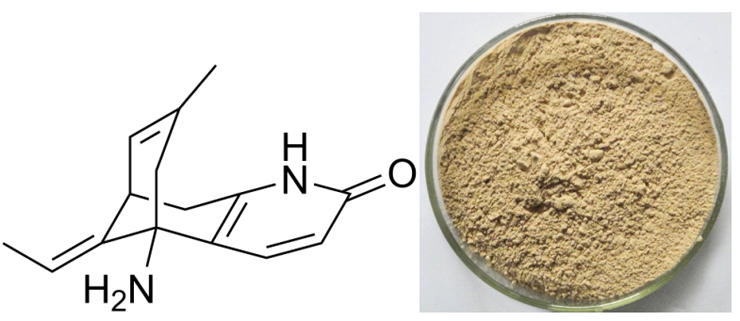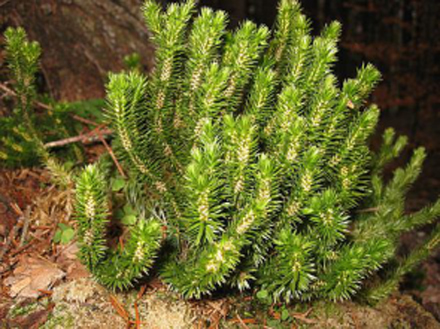Professional China Huperzine A Supply to St. Petersburg
Professional China Huperzine A Supply to St. Petersburg Detail:
[Latin Name]Huperzia serratum
[Source] Huperziceae whole herb from China
[Appearance]Brown to white
[Ingredient]Huperzine A
[Specification]Huperzine A 1% – 5%, HPLC
[Solubility] Soluble in chloroform, methanol, ethanol, slightly soluble in water
[Particle size] 80 Mesh
[Loss on drying] ≤5.0%
[Heavy Metal] ≤10PPM
[Pesticide residue] EC396-2005, USP 34, EP 8.0, FDA
[Storage] Store in cool & dry area, keep away from the direct light and heat.
[Shelf life] 24 Months
[Package] Packed in paper-drums and two plastic-bags inside.
[What is Huperzine A]
Huperzia is a type of moss that grows in China. It is related to club mosses (the Lycopodiaceae family) and is known to some botanists as Lycopodium serratum . The whole prepared moss was used traditionally. Modern herbal preparations use only the isolated alkaloid known as huperzine A. Huperzine A is an alkaloid found in huperzia that has been reported to prevent the breakdown of acetylcholine, an important substance needed by the nervous system to transmit information from cell to cell. Animal research has suggested that huperzine A’s ability to preserve acetylcholine may be greater than that of some prescription drugs. Loss of acetylcholine function is a primary feature of several disorders of brain function, including Alzheimer’s disease . Huperzine A may also have a protective effect on brain tissue, further increasing its theoretical potential for helping reduce symptoms of some brain disorders.
[Function] Used in alternative medicine, huperzine A has been found to act as a cholinesterase inhibitor, a type of medicine used to prevent the breakdown of acetylcholine (a chemical essential to learning and memory).
Not only used as a treatment for Alzheimer’s disease, huperzine A is also said to enhance learning and memory and to protect against age-related cognitive decline.
In addition, huperzine A is sometimes used to boost energy, increase alertness, and aid in the treatment of myasthenia gravis (an autoimmune disorder that affects the muscles).
Product detail pictures:

Related Product Guide:
Our mission will be to grow to be an innovative supplier of high-tech digital and communication devices by giving worth added design and style, world-class production, and service capabilities for Professional China Huperzine A Supply to St. Petersburg , The product will supply to all over the world, such as: Suriname, Angola, Libya, Our qualified engineering team will usually be prepared to serve you for consultation and feedback. We've been able to also deliver you with absolutely free samples to meet your needs. Best efforts might be made to offer you the ideal service and items. For anyone who is interested in our company and products, be sure to make contact with us by sending us emails or contact us right away. In order to know our solutions and organization. ar more, you can come to our factory to determine it. We are about to usually welcome guests from around the globe to our corporation. o create small business relations with us. Please genuinely feel no cost to speak to us for enterprise. nd we believe we have been gonna share the most effective trading practical experience with all our merchants.
Fill your spice grinder with raw, uncooked pumpkin seeds — preferably washed and dried — until it is halfway or three-fourths full, at maximum. If your grinder has fineness settings, set it to its finest consistency. pumpkin seeds grind well (wash well and sun dry for 1 day)
sieve the pumpkin seeds powder,transfer back the remaining amount into mixer and grind again.
Seal the airtight container and store your pumpkin seed protein powder in the refrigerator for maximum shelf life.
Pumpkin seeds have a well-earned reputation as a tasty, easy-to-make snack, but they also pack plentiful health benefits; these crunchy seeds feature significant amounts of magnesium, zinc, omega-3s, antioxidants, fiber and, of course, protein. pumpkin seed protein powder offers a cost-effective homemade alternative that lends itself to smoothies and baked goods alike.
Stevicure is a ayurvedic product which directly works on cause rather than working on effect. It is prepared from extracts of stevia leaves, ensuring that no vital ingredient is left out. The extraction process is carried out in the most scientific manner and in most hygenic conditions
Stevioside 12 gm
Iron 1.3 mg
Sodium 22 mg
Calcium 120 mg
Potassium 2.200 mg
Phosphor 200 mg
β-Carotene 23 ug
Vitamin A 13 IU
Vitamin B2 0.21 mg
Niacin 2.4 mg
Our body has an organ known as “Pancreas” having “Beta” cells which secretes “Insulin”. The function of Insulin is to covert the glucose/sugar available in blood in the form of energy by metabolism activities.
The “Stevicure” an elixir to Diabetes works on cause, by rejuvenating and reactivating “beta cells” of pancreas to secrete insulin and once it started naturally to secrete insulin, the cause is removed and one will enjoy normal and bliss of healthy life. In this way it controls diabetes and in many cases cure it !!
Stevicure also works on secondary failure. No other pathy or medicine is known to work on secondary failure. If a patient is suffering from secondary failure, then stevicure is the only option available for him.
“Stevicure” is wonder product from Victory herbals Having multiple benefits.
MULTIPLE BENEFITS
• It can help B cells of pancreas to secrete insulin so Sugar can be controlled.
• Helps to maintain B.P.
• Increases hemoglobin.
• Helps for digestion and bowel movement.
• Acidity will be reduced immediately.
• Teeth and bones become strong.
• It enhances physiological functions of body.
Direction of Use :
2ml or 20-25 drops in a glass of water in morning empty stomach and 20-25 drops in evening before going to sleep.
With regular use of stevicure one can enjoy a very healthy life. Many people are blessed with this miraculous product till now.
https://www.victoryherbal.com/victory/
customercare@victoryherbal.com
Cooperate with you every time is very successful, very happy. Hope that we can have more cooperation!






